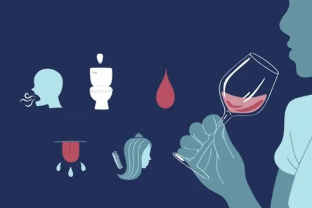
Many people do not drink alcohol during the work week, but allow themselves to relax on the weekends by drinking a few beers or stronger drinks a day. It should be borne in mind that this approach is dangerous and can cause health problems. This is due to the fact that it is difficult for the body to process a large dose of alcohol received within 2 days.
To avoid serious problems, you should know what dose of alcohol per day is considered safe.
How much alcohol not to drink
I'll say right away - there is no consensus on this issue. Some scientists claim that even in small amounts, alcohol has a devastating effect on the body. Others believe that in small doses, alcohol is even beneficial. And there are recommendations from the WHO (World Health Organization), according to which,a dangerous dose of alcoholis 60 ml of ethanol for menand50 ml for women. But since very few people consume ethanol in its pure form (well, I hope), here is what an absolutely dangerous dose of alcohol looks like in terms of drinks familiar to most:
- 180 g of vodka for men and 150 g of vodka for women
- 1. 5 l. beer
- 0. 5 l. wine
Absolutely dangerous dose of alcohol- the average value of the amount of alcohol consumed, sufficient to cause death.
But don't think that if you drink less than these values, then nothing will happen to the body. Even if you consume the equivalent of 30 ml of ethanol per day (90 g of vodka, 800 ml of beer or a tall glass of wine), you can seriously harm your health.

The formula for determining the individual alcohol level
Healthcare professionals have developed a formula that can be used to calculate an individual's alcohol consumption. Using this method, you can independently determine how much alcohol you can drink per day without harming your health.
1. 5 g of ethyl alcohol per 1 kg of human weight is taken as a basis. If a person weighs 70 kg, the individual dose of ethanol is 105 ml. In any case, it is necessary to understand that these values are averaged, since it very much depends on the age, sex and physiological characteristics of the organism.
What happens if you drink alcohol every day?
Scientists have studied this problem for a long time. Recent evidence suggests that alcoholreduces the risk of atherosclerosis. In part, it helps prevent blockage of blood vessels by cholesterol plaques. Why is cholesterol dangerous? This causes circulatory problems. Blood stops flowing normally through the vessels because they are filled with cholesterol, and the person may even die. Alcohol, on the other hand, "flushes" the blood vessels and does not allow cholesterol to stagnate.
Does this mean you can drink alcohol every day? No. In this case, we are talking about extremely low doses of alcohol. Based on the sameWHO recommendations, experts advise at least two days a week to completely abstain fromalcohol. Of course, the longer you don't drink, the better.
The optimal doseof alcohol, which is not very harmful to health, and may even bring certain benefits, is considered 150 mlof dry red wine.
But that doesn't mean you have todrink every daya little glass of wine, even though there are many stories circulating on the web, how a grandfather drank a drink every dayand lived to be 90 years old. Everything is individual here, and it is necessary to take into account many factors - from chronic diseases to hereditary predispositions. Not to mention the fact that alcoholis categorically contraindicatedfor minors and pregnant women.
Did you know that alcohol stays in your hair the longest?
If you drink alcohol every day, the body will not be able to remove it from the body, and a disease such as alcoholism will begin. It has 3 steps, and in this article we will cover them. But first, let's look at it: How does alcohol generally affect a person?
A wonderful intoxicating drink has been known for many millennia, although it was called differently in each country: digestion, beer, braga, etc. the norm to give it to children. Beer can delight you on a hot day as well as on a cool evening. For example, in the mid-20th century in Italy, they were encouraged to have fun all year round, not just in the hot summer. At that time, beer was associated with the urban lifestyle, fashion trends and even progress. And now there are many connoisseurs of this frothy drink, convinced that it can be enjoyed for breakfast, lunch and dinner.
The well-known joke "There are 24 hours in a day, 24 bottles in a beer box - a coincidence? " this confirms. But from jokes and jokes and froth, you can have good health problems if you don't know the measures. In this article, we will find out what are the advantages and disadvantages of this drink, in what quantities it can be consumed and whether there are any contraindications.
How alcohol works

The brain of an ordinary person and an alcoholic. In the second case, most of the connections in the brain are destroyed
What is alcohol in the scientific sense? This isethyl alcohol, which is made by fermenting sugar, yeast and starch. And this whole “nuclear” mixture has one amazing property: it goes through all stages of digestion incredibly quickly. That is, while you digest lunch soup (about 30 minutes) or chicken meat (up to 2 hours), the alcohol quickly serves its purpose - the human circulatory system, sometimes even bypassing the liver. , if you drink on a serious scale. She just isn't able to pass such a large amount of alcohol on her own.
Alcohol begins to do its nasty business in the circulatory system: it damages red blood cells (the tiny bodies that make up blood), which is why they stick together, forming blood clots. Blood clots, in turn, block the flow of blood through small arteries, resulting in blockage of blood vessels in the brain. As a result, the feeling of intoxication occurs, which is similar to when the brain lacks oxygen.
Red blood cells of a person who has consumed large amounts of alcohol. They are almost all stuck together
Therefore, if you do not drink alcohol in moderation, the brain will be in this state all the time. This will lead to the degradation of many mental and physical functions - a condition comparable to consuming a lot of alcohol at the same time. A person cannot stand normally and is not accountable for his actions.
Scientists have already shown that alcohol damages DNA and increases the risk of cancer.
Beer in the modern world
All stores now have a wide selection of alcoholic beverages. To make the right choice, you need to understand what the types of foam are and how they differ from each other. Beer can be divided into 2 types: simple and strong.
Regular beer is low in alcohol, around 4 percent. It is divided into 2 types: light and dark. The strength of a draft drink can reach 8%.

Strong drinks can contain up to 12% alcohol. It differs from the simple in that it has an unusual slightly bitter taste, smell and aftertaste.
This drink is considered whole. It should be noted that approximately 90% of the assortment provided to customers refers specifically to the set. The average alcohol content in this form is around 7 percent.
Stages of alcoholism
Constant consumption of alcoholleads to alcoholism, which has three stages.
- Withthe first stageaddiction to alcohol, a person gradually loses control over the amount of drunk drinking, which leads to the appearance of a pathological urge to'alcohol.
- Insecond stage, a person even develops “immunity” to alcohol, or rather, it seems to him. This is because if a person at this stage consumes more than a liter of alcohol, the body will apparently start to perceive alcohol more easily. In fact, it hides the development of serious diseases - hepatitis, cirrhosis of the liver, cancer of the esophagus and cancer of the stomach.
- Third-stagealcoholismis characterized by a complete degradation of the personality on the physical and mental planes. A person can no longer drink alcohol and in most cases dies.
Scientists believe that alcoholism is influenced by an inherited predisposition caused by insufficient production of enzymes that metabolize alcohol. But in fact, the amount of alcohol consumed affects this. You just don't need to drink if you realize that you are losing control over yourself and an unpleasant condition in the body is occurring.

Alcoholism is a disease and must be treated
Benefits of the drink
Oddly enough, beer has some valuable health benefits as well, but most of them aren't associated with drinking it indoors. It is used externally:
- Beer foam is used to smooth wrinkles from masks which improve the condition of the skin of the face.
- Beer is an essential ingredient in hair masks, which makes them strong, voluminous and silky.
- If a person gets sick with acute respiratory infections and drinks some hot beer, the healing and improvement in health will be faster.
- A reasonable dose of beer will help remove harmful heavy metals from the body, so drink the drink at an acceptable rate and your kidneys will be healthy.
- If you drink beer occasionally, the skeletal system will become stronger due to the silicon content.
Watch your health!
WARNING! The information published in the article is for informational purposes only and does not constitute instructions for use. Be sure to consult your doctor!
Why does a hangover happen?
A lot of people ask this question in the morning after a hectic party (usually with the words "well, I won't drink anymore"). In fact, the explanation is quite simple: Alcohol enters the body's bloodstream very quickly, but leaves it VERY slowly. And the human body cannot fully recover from a stormy night until the substance is completely destroyed and digested. This is how thehangoveroccurs.
Last year in our country they tried to make a hangover beer with vitamins. I wonder if they did?
Surely many have asked,how to avoid a hangover, before starting to celebrate another event with alcohol. But the answer can be summed up in one sentence: don't drink in large amounts, and the alcohol will then have time to leave the body before your head hits the pillow.
How to drink alcohol?
Researchers distinguish between the so-called "Nordic" model of alcohol consumption and the "southern" model. The first includes Belarus, Kazakhstan, the Baltic countries, which drink a lot of alcohol, moreover in shock doses, and not always often. The “southern” model is typical of Spain, Italy, Greece, where they can drink even more often, but less and less strong alcohol: for example, a glass of dry wine at dinner. No one drinks 100 g of vodka every day.
Scientists agree that the Southern model is safer for your health, although they still note that daily consumption of alcohol is harmful to your health. So don't get overused.
Historical data
Beer is one of the oldest drinks. If you believe the story, then for the first time it was prepared about 8, 000 years ago. It should be noted that at that time it was women who engaged in the manufacture of the drink. It was produced mainly at home. Only after beer began to gain popularity and sell, men became interested in the production business.
Of course, in our time, brewing is considered an exclusively male profession, although, as is known from history, it all started in a completely different way. Most of the drink was produced in the Middle Ages and was renowned for its delicious taste in England, the Czech Republic and Germany. It is for this reason that these countries have not lost their title and continue to make a delicious intoxicating drink.
This case was popular in many countries. People who could brew beer were held in high regard. Different ingredients were chosen for the production, so the taste of the beer was also different.
























